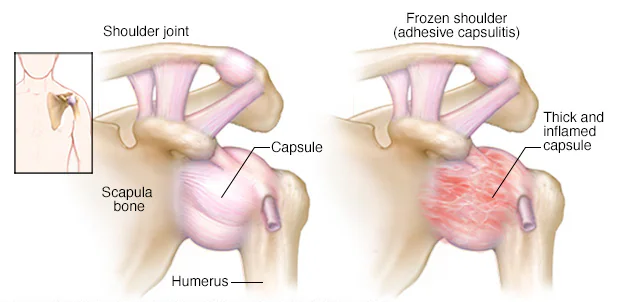July 23, 2024
What is Frozen Shoulder?
Having to keep a shoulder still for a long period increases the risk of developing frozen shoulder. This might happen after having surgery or breaking an arm.
Treatment for frozen shoulder involves range-of-motion exercises. Sometimes treatment involves corticosteroids and numbing medications injected into the joint. Rarely, arthroscopic surgery is needed to loosen the joint capsule so that it can move more freely.
It's unusual for frozen shoulder to recur in the same shoulder. But some people can develop it in the other shoulder, usually within five years.
Symptoms
Frozen shoulder typically develops slowly in THREE stages.
- Freezing stage: Pain increases, and shoulder motion becomes more limited.
- Frozen stage: Pain may begin to diminish, but the shoulder remains stiff.
- Thawing stage: Range of motion gradually improves.
For some people, the pain worsens at night, sometimes disrupting sleep.

Age and sex
People of 40 years and older, particularly women, are more likely to have frozen shoulder.
Immobility or reduced mobility
People who’ve had to keep a shoulder somewhat still are at higher risk of developing frozen shoulder. Restricted movement can be the result of many factors, including:
- Rotator cuff injury
- Broken arm
- Stroke
- Recovery from surgery
Systemic diseases
People who have certain diseases appear more likely to develop frozen shoulder. Diseases that might increase the risks include:
- Diabetes
- Overactive thyroid (hyperthyroidism)
- Underactive thyroid (hypothyroidism)
- Cardiovascular disease
- Parkinson’s disease
Prevention
One of the most common causes of frozen shoulder is not moving a shoulder while recovering from a shoulder injury, broken arm or stroke. If you’ve had an injury that makes it difficult to move your shoulder, talk to your health care provider about exercises that can help you maintain your ability to move your shoulder joint.
Diagnosis
- Physical examination: A doctor will assess pain and range of motion.
- Imaging tests: X-rays or MRI may be used to rule out other conditions.
Treatment
- Physical therapy: The primary treatment involves exercises to restore motion.
- Medications: Pain relief through NSAIDs or corticosteroid injects.
- Heat application: Applying heat to the shoulder can help reduce pain before stretching exercises.
- Surgical options: In severe cases, procedures like shoulder manipulation or arthroscopic surgery may be necessary.

